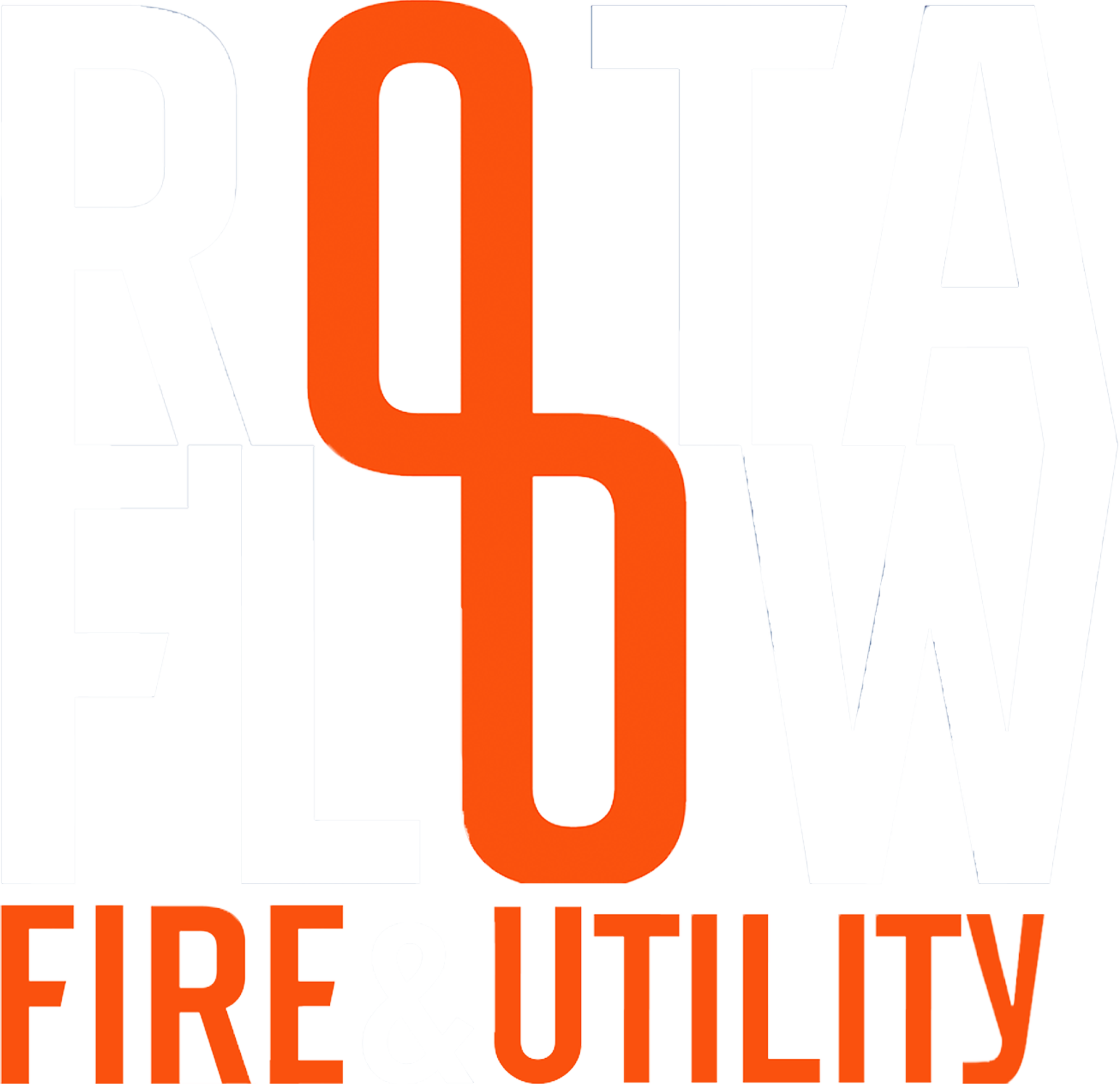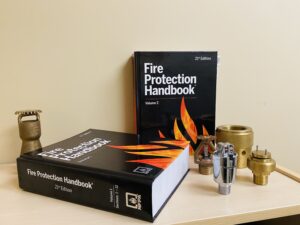Summary- The article addresses various fire protection and safety code questions. It covers topics such as the omission of sprinklers under non-combustible projections with occupancy above, regulations for townhouse sprinkler mains, and the distinction between ice obstruction inspections and internal condition assessments. It also discusses requirements for underground CPVC pipes and pressure reducing valve flow testing. Additionally, the article touches on gauge placement in dry standpipes and the necessary tank refill rate as per NFPA standards.
Question #1 – Exterior Projection with Occupancy Above
Are sprinklers permitted to be omitted under the exterior non-combustible projections with the occupancy above in accordance with the 2013 edition of NFPA 13?
Answer- Yes, because there is an inhabited level above, sprinklers are not particularly needed by NFPA 13 as long as the outer projection is constructed in accordance with requirement 8.15.7.2. However, this response requires further explanation.
Sprinklers should be installed where there is occupation above the sections under external ceilings, according to the annexe remark for this part. This is not enforceable and is not a requirement of NFPA 13 because it is contained in the document’s annexe. In this situation, the owner and the responsible design professional should be consulted, and it would be necessary to evaluate the requirements of the building code.
It’s also important to point out that the technical committee of NFPA 13 has addressed this idea in NFPA 13’s later versions. The committee said that the annexe should not indicate that sprinklers are required beneath outside projections where there is a floor above as this is an issue handled with by the building code, which is why the annexe wording described above was deleted in the 2019 version of NFPA 13. Point to be united here is that a new provision (9.2.3.2.1) was introduced to the NFPA 13 in the year 2022 and calls for sprinklers to be installed for “porte cochere that is located directly below floors intended for occupancy.”

Question #2 – NFPA 13D Townhouse - Sprinkler Main Penetrating the Walls
There is a 6 unit townhome building plated on individual lots. Is it permissible in accordance with the International Residential Code for the service main to run from one end of the building to the other end penetrating all the party walls/property lines?
Answer- The International Residential Code (IRC) 2021 edition does, in fact, permit this layout. The IRC permits fire sprinkler pipe to pass through townhouse double walls and common walls. Through penetrations of fire-resistance certified wall or floor assemblies are covered in Section R302.4.1. With the requirement that the annular gap is filled with a material that complies with condition 1.2 in Exception #1, the NFSA created an exception to the IRC that permits water-filled sprinkler pipe to pass through fire separations.
For the duration of the time period equating to the fire-resistance rating of the construction penetrated, the material must adhere to ASTM E119 or UL 263 time temperature fire conditions under a positive pressure differential of at least 0.01 inch of water at the location of the penetration.
To further clarify this idea, an annexe diagram was included in the 2019 edition of NFPA 13D. An suitable layout for townhouses is shown in Annex Figure A.6.2(e), which depicts a single feed main servicing each individual unit. It is made clear in a remark on this image that this feed main can be run “at the exterior or within the building.”
Question #3 – NFPA 25 Ice Obstruction Versus Assessment of Internal Condition of Piping
Does the annual ice obstruction inspection for a freezer preaction system found in section 14.4 of the 2014 edition of NFPA 25 satisfy the requirements of the 5 year Assessment of Internal Condition of Piping outlined in 14.2?
Additionally, does utilizing an air dryer or nitrogen for the preaction system air supply change the assessment requirements of 14.2?
Answer- No, because these are two distinct needs from two separate areas of the standard, the yearly ice obstruction inquiry does not satisfy the internal assessment’s requirements. Additionally, the internal assessment standards are unaffected by the use of air dryers or nitrogen.
Question #4 – Underground CPVC Thrust Blocks
Do solvent welded joints on listed CPVC pipe qualify as a restrained joint system in accordance with 10.6.2 of NFPA 24 (2019) to not require thrust blocks?
Answer- Although CPVC underground pipe (with solvent-cemented joints) is not expressly covered by section 10.6.2 “Restrained Joint Systems,” it does not call for extra thrust blocks.
The charging statement for the restraint requirements is found in Section 10.6 of the 2019 version of NFPA 24, which is named “Restraint”. According to this rule, all subterranean plumbing must be constrained using one of the three techniques described in the following sections:
1.Thrust Blocks, Section 10.6.1
2.Restrained Joint Systems, Section 10.6.2
3. 10.6.3 – Extra techniques.
Under section 10.6.3, which specifies that additional restraint (such as thrust blocks) is not necessary when the pipe is linked by one of the following ways (and will not shift during the hydrostatic test), CPVC with solvent-cemented joints is covered.
1.Tight Threaded Connections
2. Rhythmic Connection
3.Bonds That Were Welded
4.Heated Connections
5. connections glued using chemicals or solvents
Due to CPVC’s compliance with subsection (5) of 10.6.3, further restraints (thrust blocks) are not necessary. In reality, it is clearly stated in the annexe section of 10.6.3 that CPVC pipe with solvent-cemented joints is regarded as restricted and does not need thrust blocks.
Question #5 - Pressure Reducing Valve Flow Testing
What does NFPA 14, 2019 edition, mean when it says it requires “full flow testing” of pressure reducing of the hose valves? And is there a different volume required for PRVs versus standard hose valves?
To make sure each standpipe satisfies the criteria for flow and pressure described in Sections 7.8 and 7.10, a standpipe system must be flow tested concurrently from the hose connections. To do this, it is necessary to concurrently flow each standpipe to the necessary flow while checking that the most remote outlet satisfies the necessary design pressure of 100 psi.
Each standard hose valve must be manually opened, closed, and operated to its full range. Standard hose valves are not subject to any special flow test requirements (Section 11.6).
To ensure that the installation is accurate and that the input and outlet pressures are in compliance with the design, pressure-regulating devices must undergo independent testing. The test certificate must include the static and residual input and exit pressures. (See Section 11.5.5.)
Question #6 - Gauges for Dry Standpipes
There is no pressure in the dry standpipe except for when they are energized by the fire department. Are gauges required at the top of dry standpipes that are fed solely from fire pumper trucks? If they are required, are they required at the top of every standpipe riser?
Yes, all standpipes must include a gauge at the top of each riser, according to Section 5.5.1 of the 2016 version of NFPA 14, Standard for the Installation of Standpipes and Hose Systems. The standard does, however, permit the installation of a single gauge in situations when several standpipes are linked at the top.
Manual dry standpipes are not excluded from the norm.

Question #7 – Water Tank Refill
The water supply on a project consists of a 1,000 gpm pump taking water from an on-site water storage tank. What is the required refill rate for a tank in accordance with the 2018 edition of NFPA 22?
Answer- According to NFPA 22, an 8-hour replenishment rate is necessary. Sections 14.4.2 and 4.2.1.4 of the 2018 edition of NFPA 22 make mention to this.
According to section 14.4.2, the method used to fill the tank must comply with section 4.2.1.4, which stipulates that the water supply must be “capable of filling the min required fire protection volume in the tank in a max of 8 hours.”
All of the specifications for filling a tank are listed in Section 14.4 under the heading “Filling.”
Additionally, it should be noted that the refill rate may be utilized to lessen the total needed tank capacity in addition to being used for the basic refilling of the storage tank.
For instance, Section 4.1.6 specifies that the tank must be designed such that the system demand is satisfied for the necessary design period by the stored capacity plus the “reliable automatic refill”
In order to satisfy demands for water supply capacity, the break tank idea also relies on precise refill rates. For further information on this topic, see Section 14.5.
Question #8 – Sprinkler Testing
A project required that the sprinklers be tested (or replaced) in accordance with NFPA 25. The project is a five-story building with approximately 1,700 sprinklers.
A sprinkler on the first floor failed. Does this mean all the sprinklers in the building need to be replaced or just the sprinklers on the first floor?
What was provided as the sample area will determine the answer. All sprinklers will need to be replaced if 1% of the 1,700 sprinklers were tested as a single sample. If you submitted 1%, or at least 4 samples from various sample locations, just the sample area that failed would need to be replaced. The illustration below was taken from a 2019 NFSA magazine article.
Example:
The inspector and/or the building owner may choose the sample area or groups of sprinklers based on section 5.3.1.2. Don’t forget that sprinklers shouldn’t be selected from the same levels or regions of the building just because they are simpler to access than others.
A five-story apartment complex with 100 sprinklers on each level was utilised in this illustration.
A minimum of four sprinklers from each level, or 20 sprinklers, would need to be taken from the sample area if it were picked by floor. It is necessary to take 1%, or 5 sprinklers, as the sample area if the entire building were the sample area. Take note of the distinction between sending out 5 sprinklers for testing and 20 sprinklers.
If one sprinkler in a representative sample does not pass the test, all sprinklers in the sample area that sample represents must be replaced, according to Section 5.3.1.3.
As a result, if one sprinkler malfunctions, the whole sprinkler system in the sample area needs to be replaced. Only the 100 sprinklers on that level would need to be replaced in the example above if the by floor sample was utilized and one sprinkler on a floor failed. The building’s 500 sprinklers would need to be replaced if the entire sample was taken, and one sprinkler failed.
The contractor and the building owner should talk about this information to debate the advantages and disadvantages of various sampling regions and sizes.
Question #9 – Dry Fire Sprinkler System Inspectors Test & Auxiliary Drains / Building Seismic Joint
Are there any special requirements in the 2016 edition of NFPA 13 for seismic bracing of an inspector’s test where it crosses a building seismic joint, for a dry fire sprinkler system in a below grade parking garage?
Answer- No, an inspector’s test pipe system is free from seismic bracing and restraint since it does not fit the definition of a branch line, cross main or feed main, with the exception of flexible couplings in Section 9.3.2.3.1(6). According to Section 9.3.3.1, it would be regarded as “sprinkler piping” for the seismic separation assembly; however, piping below grade in a parking garage is exempt from the requirement for a seismic separation assembly.
Question #10 – Draining Multiple Adjacent Trapped Branch Lines
Is a drum drip needed where tie-in drains are provided for multiple adjacent trapped branch lines per NFPA 13, 2013 edition, Section 8.16.2.5.3.6, and the capacity of trapped section is more than 5 gal?
Yes. The branch lines in issue have trapped pipes with a capacity of more over 5 gallons, thus they would need to meet the conditions for a “drum-drip” or condensate nipple described in section 8.16.2.5.3.5. Section 8.16.2.5.3.6 (tie in drains for several nearby trapped branch lines) does not contain any phrase that would supersede the necessity for a “drum drip.”
It is important to be aware that the manual commentary for section 8.16.2.5.3.6 opposes the use of tie-in drains for several branch lines since doing so would result in a gridded drain system and could prolong the time it takes for water to discharge.
Question #11 – Group A Plastics with Fire Retardant
If a Group A plastic commodity is treated with a fire retardant, is it still considered by NFPA 13 to be a Group A plastic?
Answer- The categorization of a Group A plastic with the addition of a fire retardant is often unaffected, however it relies on the quantity and judgement of the design expert. The inclusion of a fire retardant should not be the “…sole basis for a reduction in classification,” as stated in Section A.20.4.5 of the 2019 edition of NFPA 13. A full-scale or commodity classification type test would be required, the annexe note continues, “to justify any such reduction in classification.”
The design expert would have to decide this, as was said before. It is necessary to take into account the entire unit load, including packing, in accordance with Sections 20.4.5.3 or 20.4.5.4.
Question #12 – Hanger Requirement for Exposed Armover with Upright Sprinklers Over 100 PSI
Can upright sprinklers on 1″ be installed on an unsupported armover up to 2 feet where the system pressure exceeds 100 psi?
Answer- Yes, even when the system pressure surpasses 100 psi, you can install an upright sprinkler on an unsupported armover with a cumulative length no longer than 2 feet.
Unsupported armovers must adhere to the requirements of NFPA 13, 2016 edition, Section 9.2.3.5, which states that the total horizontal length of an unsupported armover to a sprinkler, sprinkler drop, or sprig must not be more than 24 inches for steel pipe. All armovers, including those for upright sprinklers, are covered under this section. The standard does not mandate that an armover have a hanger if it is feeding an upright sprinkler with a cumulative horizontal length of 24 inches or less for steel pipe.
The unsupported armover length with a maximum pressure more than 100 psi and a branch line above the ceiling feeding sprinklers in the pendent position below the ceiling are addressed in section 9.2.3.5.2. According to this section, where a branch line above a ceiling supplies sprinklers in a pendent position below the ceiling and the maximum static or flowing pressure, whichever is greater at the sprinkler, applied other than through the fire department connection, exceeds 100 psi, the cumulative horizontal length of an unsupported armover to a sprinkler or sprinkler drop shall not exceed 12 inches for steel pipe.
This part limits the unsupported cumulative length for steel pipe to 12 inches and is only relevant to movers who provide pendent sprinklers below the ceiling, thus it would not apply to your situation if you were utilising upright sprinklers.

Courtesy: Roland ASP, CET NFSA Technotes (Best of September 2022)



